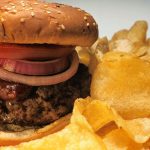
Americans’ love affair with fast food continues, with 1 in every 3 adults chowing down on the fare on any given day. That’s the finding from a new report from the U.S. Centers for Disease Control and Prevention. When asked by researchers, 37 percent of adults said they’d eaten fast food at least once over the past 24 hours. There was one surprise: Bucking the notion that poorer Americans favor fast food the most, the report found that intake actually rose with income. For example, while about 32 percent of lower-income folks ate fast food daily, more than 36 percent of middle-income consumers had fast food on a given day, as did 42 percent of those with higher incomes, the report found. Whatever your income bracket, fast food probably isn’t doing your health any favors. That’s because it “has been associated with increased intake of calories, fat and sodium,” the CDC team said. All that adds up to widening waistlines and hardening arteries, one nutritionist warned. “Most fast food is not good for our bodies,” said Liz Weinandy, a registered dietitian at Ohio State University’s Wexner Medical Center. “The more of it we eat, the more likely we are to be overweight or obese and have increased risk for several diseases like type 2 diabetes, heart disease and metabolic syndrome when talking to patients,” she… read on >






































